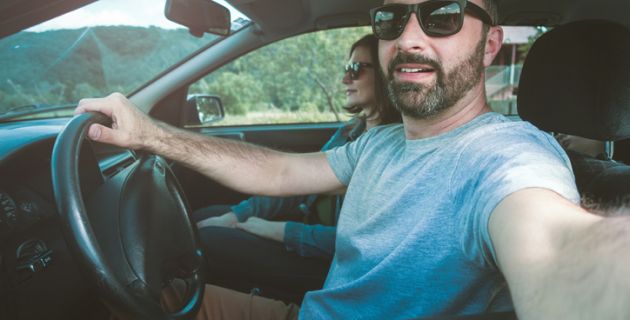Over the last decade, the complete domination of smartphones as our way to communicate has allowed platforms like Facebook, Instagram, Twitter, YouTube, and Spotify to be available wherever and whenever. These social media and video and music services have given us novel ways to connect, entertain, and distract.
However, an unfortunate byproduct of the digital age is that these diversions are so effective and addicting that often people willfully choose to play with their phones as they drive, despite the inherent risks.
Below, we will discuss the statistics underlying social media use and driving, as well as other bad driving habits.
Distracted Driving
The 2009 Overview of the National Highway Traffic Safety Administration (NHTSA) Driver Distraction Programdefines distracted driving in the following manner:
Although the definition may seem obvious, the term distracted driving has been used to represent different driver conditions. Some reports or news articles use the terms inattention and distraction synonymously. While drowsiness and daydreaming can be categorized as inattention, the term distraction as used in this plan is a specific type of inattention that occurs when drivers divert their attention away from the driving task to focus on another activity instead.
NHTSA lumps distractions into one of three categories, which includes:
- Visual Distractions, or actions that necessitate the driver looking away from the road to obtain visual information.
- Manual Distractions, or actions that necessitate the driver removing their hand from the wheel to operate a device.
- Cognitive Distractions, or actions that take the driver’s mind off the road and forces them to focus on something else.
Social media and cell phone use is the perfect storm of distracted driving since it can be a visual, manual, and cognitive distraction, only adding to the list of bad driving habits that already exists. As tech companies release more apps and features every day, the potential driving distractions multiply exponentially.
Distracted Driving Statistics
In 2017, 37,133 Americans were killed in automobile traffic collisions. According to the NHTSA, 3,166 of the total fatal crashes were attributable to distracted driving. Although this was a 9% reduction from the 3,450 distracted driving fatalities in 2016, it still accounted for 8.5% of all motor vehicle fatalities. Tragically, in 2017, 7% of the people who died in distraction-affected crashes were teens ranging from 15 to 19 years old.
These staggering fatality numbers fail to account for the thousands of non-fatal crashes that resulted in injury, car damage, lost time, and traffic delays. In 2016 alone, there were 634,000 crashes caused by distracted driving; of these, 47,000 crashes involved cell phone use; of that figure, 25,000 of the accidents attributable to cell phone distraction resulted in serious injury.
Social Media and Distracted Driving

A 2015 AT&T Smartphone Use Behind the Wheel Survey polled a sample of 2,067 respondents between the ages of 16 and 65, and made some shocking discoveries:
- 61% said they had texted while driving.
- 33% said they had emailed while driving.
- 27% said they had browsed, commented or posted on Facebook while driving.
- 14% said they had perused Twitter or tweeted while driving.
- 14% said they had scrolled through Instagram or posted a photo or video while driving.
- 11% said they had scanned Snapchat or sent a Snap while driving.
The reasons that were given for their willingness to engage in such unsafe driving included:
- A habit or addiction to social media. This was the most common excuse given; they simply were used to having their phone in their hand.
- Reading texts or emails. FOMO (fear of missing out) was the other most common excuse given. Teens didn’t want to miss out on what had been said to them.
- Responding to texts or emails. Most parties believed that they were capable of multi-tasking safely.
Shockingly, the survey above may be on the more modest side. A recent 2018 survey of some 7,500 respondents found that approximately 90% of drivers will use their smartphone while driving, including:
- Texting – 81%
- Listening to Music – 64%
- Snapping or Viewing Photos– 64%
- Emailing – 60%
- Accessing Social Media – 50%
- Accessing the Internet – 47%
- Watching or Streaming Videos – 36%
- Playing Games – 28%
- Video Chatting – 27%
Clearly, this is a universal problem. It indicates that millions of drivers at one point or another will multitask as they drive. The potential danger is even larger if drivers engage in multitasking while navigating other dangerous road conditions, such as driving on black ice or snow. Sadly, if nothing is done to prevent such actions, this problem will likely only get worse and our roads will become even more unsafe and cluttered with distracted drivers.
Why Seconds Matter
If these surveys are any indicator, you’ve likely broken the rules yourself. In such cases, you might think it’s no big deal, it will only be a few seconds. Sadly, what many fail to recognize is that when you are in a one-ton vehicle, hurtling through space at 70 MPH, 5 seconds is practically an eternity. In that time, you will cover nearly 2 football fields, meaning that a vehicle that seems far away is really much closer than you think.
You wouldn’t drive blindfolded, would you? Using your phone to scroll through social media, send a text, or change a song is virtually the same as closing your eyes. Even if it’s only for a second, that can be the difference between life and death.
Make no mistake, driving distracted is a dangerous activity that not only puts your life in danger, but also puts innocent lives at risk. The next time you are on the road, think about some of these numbers and resist the temptation. Put away your phone. Ignore your social media, text messages, and email alerts. Don’t become another statistic.